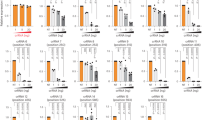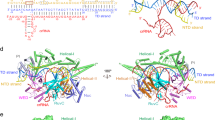Abstract
In this report, we examined the effect of increased target site access on activated human RNA-induced silencing complex (RISC*) catalysis. Kinetic studies revealed that siRNA-programmed RISC* cleaved target RNA with higher efficiencies when target site access was increased. These results provide evidence that target site access is linked to RISC* catalysis.


Similar content being viewed by others
References
Fire, A., et al. Nature 391, 806–811 (1998).
Song, J.J. et al. Science 305, 1434–1437 (2004).
Liu, J. et al. Science 305, 1437–1441 (2004).
Meister, G. et al. Mol. Cell 15, 185–197 (2004).
Hutvagner, G. & Zamore, P.D. Science 297, 2056–2060 (2002).
Rana, T.M. & Jeang, K.T. Arch. Biochem. Biophys. 365, 175–185 (1999).
Hutvagner, G. et al. PLoS Biol. 2, E98 (2004).
Kozak, M. Gene 234, 187–208 (1999).
Acknowledgements
We thank members of the Rana lab, C. Mello and P. Zamore for helpful discussions; T.J. Richman for editorial assistance; and H. Cao for kinetic data analysis. This work was supported in part by grants from the US National Institutes of Health (AI 41404 and AI 43198) to T.M.R.
Author information
Authors and Affiliations
Corresponding author
Ethics declarations
Competing interests
The authors declare no competing financial interests.
Supplementary information
Supplementary Fig. 1
Cdk9 RISC concentration. (PDF 295 kb)
Supplementary Fig. 2
GFP RISC kinetics. (PDF 209 kb)
Supplementary Fig. 3
GFP and Cdk9 initial velocity. (PDF 495 kb)
Rights and permissions
About this article
Cite this article
Brown, K., Chu, Cy. & Rana, T. Target accessibility dictates the potency of human RISC. Nat Struct Mol Biol 12, 469–470 (2005). https://doi.org/10.1038/nsmb931
Received:
Accepted:
Published:
Issue Date:
DOI: https://doi.org/10.1038/nsmb931
- Springer Nature America, Inc.
This article is cited by
-
Ribosomes clear the way for siRNA targeting
Nature Structural & Molecular Biology (2020)
-
Inhibition of hepatitis C virus using siRNA targeted to the virus and Hsp90
Cell Stress and Chaperones (2017)
-
In vivo therapeutic potential of Dicer-hunting siRNAs targeting infectious hepatitis C virus.
Scientific Reports (2014)
-
Silencing Mutant ATXN3 Expression Resolves Molecular Phenotypes in SCA3 Transgenic Mice
Molecular Therapy (2013)





